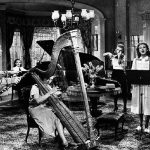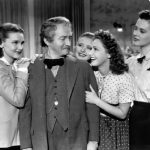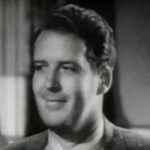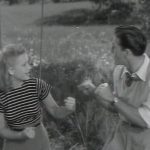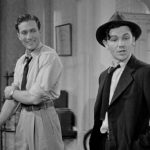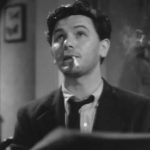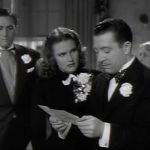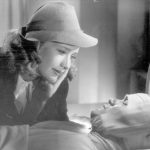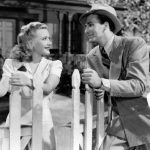
Four Daughters – 1938
I actually liked this movie, despite the fact that I knew absolutely nothing about it before sitting down to watch it. It had three names that I really recognized, and because this movie was an ensemble piece without a real lead, these actors were in supporting roles. Claude Rains, John Garfield, and Frank McHugh have each stood out to me as good actors in other films.
The movie was about, you guessed it, four daughters. Claude Rains played the father of the four gorgeous girls, Adam Lemp, a snooty old man who believes that classical music is the only real music. He turns up his nose at anything else like jazz. He had obviously never heard any Gershwin. His sister Aunt Etta, played by May Robson, was a kindly old lady who mothered the house, since Adam’s wife was absent. And come to think of it, nobody ever mentioned her, and no explanation was ever given for her absence.
Priscilla, Rosemary, and Lola Lane played the first three daughters, Ann, Kay, and Thea. The fourth, Emma, was played by Gale Page. Now, Wikipedia describes the movie as a musical drama, but let me debunk that myth. It was a romantic drama that had a few scenes in which there is classical music being played by the characters. The music was secondary to the scenes and could have easily been taken out. In other words, it was not an essential part of the plot, nor did it promote any character development.
And while I’m on the subject, I have to mention that I am a musician, myself. For the most part, I know when I’m seeing someone actually play their instrument. Claude Rains was not playing his flute, but Priscilla Land was most definitely playing her violin. Kay was probably doing her own singing. They never showed Thea’s hands on the keys of the piano, but I can assume she was really playing. And Emma seemed to be playing her harp.
Now, based on the era and the story set-up, when the movie started, I assumed that each of the daughters was going to end up with a man, and this was almost true. Kay seemed to value her career as a singing prodigy more than finding a husband, which was refreshing, because as we all know, a 1930s woman was nothing if she didn’t have a husband. Although, I have to mention that there was a scene in which Ann and Emma dream fondly of becoming old maids together because the idea of a man coming between them was unimaginable. But aside from Kay, I was right… sort of.
But the men came, seemingly all at once. Dick Foran, played Ernest Talbot, ended up with Emma. Frank McHugh played Ben Crowley, who married Thea. Jeffrey Lynn played Felix Deitz, and though he proposed to Ann, she stood him up at the altar. Why? So she could marry Mickey Borden, played by John Garfield. The intricacies of who loved who, who married who, and who was happy with who were what made the plot interesting.
Of all the daughters, the film seemed to focus on Ann, though they were pretty good about giving all four of the daughters their own threads in the tapestry of the plot. And the ending had a little twist that was clever enough. As it was an ensemble cast, I have to say that they all played their parts well, and it was a pretty popular movie in 1938. It had to have been. How else could it have spawned the two sequels, Four Wives in 1939, and Four Mothers in 1941.
But if an actor stood out to me as a step above the rest, had a hard time choosing between Rains and Garfield. Rains created a very lovable character who tried to portray an air of being a grouchy old man, but who was clearly a lovable teddy bear at heart. And Garfield’s Mickey was probably the most complex character in the movie. He had a woe-is-me sense of doom that he did his best to overcome, and when he found that he could not, he surprised me by making a noble sacrifice.
All in all, the movie was a partly predictable piece of fluff that was so cleverly written that I didn’t mind its clichés. This is a film that would probably do well if it were written into the form of a stage play. The staging could be easily accomplished. The characters are light and frothy, and the romances are, for the most part, easy and understandable. I find myself mildly curious about the plots of the two sequels, but not enough to do anything more than wonder.
And I’m going to take an aside for a moment here, to mention the disappointing end to John Garfield’s career. He really was a brilliant actor who could have had a long and prolific career in Hollywood. Unfortunately, John was caught up in the Red Scare of the late 40s and early 50s. He was blacklisted around 1952. This caused his marriage to fall apart, and he never worked in Hollywood again. Then, when Garfield was 39 years old, he died of a heart attack. Just sad.
